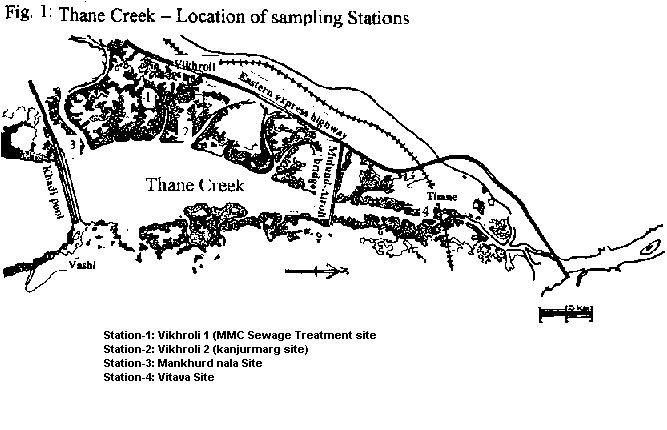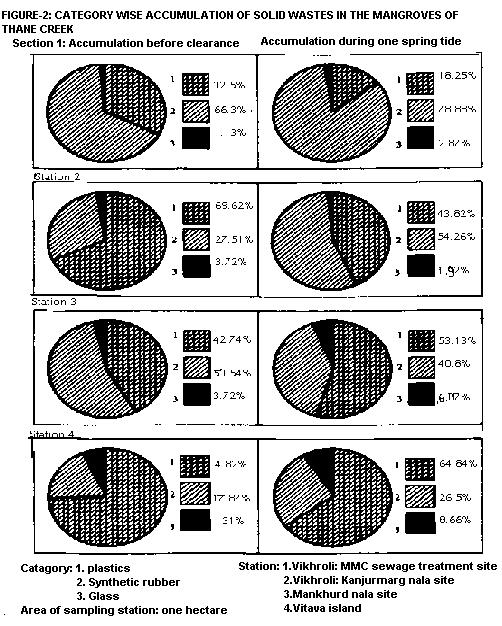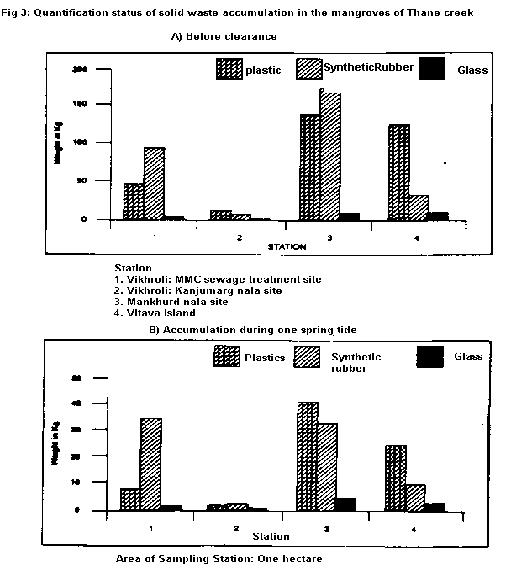
|

|

|

QUANTIFICATION STUDIES ON THE ACCUMULATION OF NON -BIODEGRADABLE SOLID WASTE MATERIAL IN THE MANGROVES OF THANE CREEK
Mahesh Shindikar1 , Sandeep Jadhav1, Rajendra Karpe1, Manish Lale2 , P. Tetali2 and V.R. Gunale1


|

|

|


 ABSTRACT
ABSTRACT
 INTRODUCTION
INTRODUCTION
 MATERIALS AND METHOD
MATERIALS AND METHOD
 RESULTS
RESULTS
 CONCLUSION
CONCLUSION
 ACKNOWLEDGEMENT
ACKNOWLEDGEMENT
 REFERENCES
REFERENCES
 TABLE 1: ACCUMULATION OF NBDSW MATERIAL AT SAMPLING STATIONS
TABLE 1: ACCUMULATION OF NBDSW MATERIAL AT SAMPLING STATIONS
 FIGURE-1: THANE CREEK - LOCATION OF SAMPLING STATIONS
FIGURE-1: THANE CREEK - LOCATION OF SAMPLING STATIONS
 FIGURE-2: CATEGORY WISE ACCUMULATION OF SOLID WASTES IN THE MANGROVES OF THANE CREEK
FIGURE-2: CATEGORY WISE ACCUMULATION OF SOLID WASTES IN THE MANGROVES OF THANE CREEK
 FIGURE-3: QUANTIFICATION STATUS OF SOLID WASTE ACCUMULATION IN THE MANGROVES OF THANE CREEK
FIGURE-3: QUANTIFICATION STATUS OF SOLID WASTE ACCUMULATION IN THE MANGROVES OF THANE CREEK
| ABSTRACT: |




|
Accumulation of three major non-biodegradable solid wastes viz. plastics, synthetic rubber and glass was studied in the mangroves of Thane creek. Quantification of these materials during one spring tide was done in selected mangrove habitats. Disturbed habitats show high values of industrial and domestic solid wastes. Accumulation of 19.95 kg. of plastics at Vitava station, 32.12 kg. of synthetic rubber at Mankhurd station and 1.2 kg of glass material at Vikhroli site was recorded during one spring tide. The solid waste pollutants from various point and non-point sources are affecting the mangrove ecosystem. Quantification studies of the non-biodegradable solid wastes represent an important and neglected aspect of coastal pollution.
| INTRODUCTION: |




|
Non-biodegradable solid waste (NBDSW) or refuse is a carpet word. It covers a variety of materials ranging from asbestos to Zinc batteries. Polythene and its related compounds are the most commonly found solid waste materials in urban environs. Many non-biodegradable solid waste materials are known to cause considerable environmental hazards when released into land, water and atmosphere. Various workers have highlighted the problems related to solid waste in recent years. The dangers are so vast that India alone generates about 800 to 3,200 tons of plastic waste per day. Solid waste related problems prevail more in megalopolis and the dangers reach great heights in coastal cities. Solid wastes of domestic and industrial units are considered major pollutants of coastal regions of India. Nearly 44000 m3 of domestic sewage and 440 m3 of industrial waste are discharged every year into the seas of India.
Mumbai is one of the biggest megalopolis of India and generates about 365 million tonnes of sewage annually (Glasby G.P. and Roonwal G.S., 1995). Most of the sewage is carried through gutters and reaches the sea at various points or dumped indiscriminately into the sea. The Thane creek of Mumbai is the biggest sink for most of the waste generated by residential and industrial complexes.
Incidentally, the Thane creek is one of the biggest natural creeks of India and is guarded by mangroves. Mangrove ecosystem plays an important role in the survival of many coastal communities and harbors a unique biodiversity (Untawale, A.G, 1986; Deshmukh, S.V, 1990). The mangrove forests are important for various reasons. Their role in harboring a variety of biotic communities, protecting the coastal areas from cyclonic storms and functioning as lungs in the case of Mumbai, is of considerable importance from the conservation point of view.
A big mangrove patch at Vikhroli region of Thane creek is managed by private organisations (Godrej and Boyce Mfg. Co. Ltd. and Soonabai Pirojsha Godrej Foundation). This region is identified as one of the seven mangrove 'hot-spots' of Maharashtra (Report on 'Marine Protected Areas along the Maharashtra Coast' - Sept. 1998, Nagpur FD). In recent years, there has been much concern over marine pollution, particularly the Thane creek. Various hazardous materials have been identified and detected from the creek as well as the marine organisms. It is thus necessary and mandatory to identify the type and intensity of pollution for any improvement programs.
Despite the crisis, no detailed quantification studies on the accumulation of NBDSW material have been made. Understanding the existing status, an attempt has been made in the present study to quantify the accumulation of three important types of NBDSW material in the mangroves of Thane creek.
| MATERIALS AND METHOD: |




|
The present study area is situated at Lat. 19000'-19015'N and Long. 72055'-73000'E.
The entire study area covers a stretch of 41.25 km2 from Mumbai harbor to Ulhas river near Thane. The total mangrove cover of the study area is about 14.37 km2 (Naskar K. and Mandal R., 1999). Three municipal corporations, viz. Greater Mumbai, New Mumbai and Thane surround the creek. The study area is also surrounded by many industries and considered to be the biggest industrial complex in Asia. The population was about ten million in these three cities as per 1991 census (District Census Handbook, Thane District, 1991).
For the purpose of study, the area is classified according to the levels of disturbance and type of habitat. The two major types of habitat identified in the study area are the partially protected and the disturbed. Privately owned mangrove area of Vikhroli is identified as partially protected, since it is protected from human interference and rest of the study area is recognized as disturbed. Four stations, representing east and west bank of the creek, were selected for the study. These are,
A) Stations from partially protected areas
B) Stations from disturbed areas
Locations of sampling stations with reference to Thane creek are shown in Fig. 1. A total of four hectares, one hectare at each station, was studied for the purpose. Due to the non-availability of continuous one hectare patch of mangroves at some of the stations, four 50 x 50 m2 quadrats were used. In all, 16 quadrats were studied in four stations.
The solid waste accumulated in the mangrove vegetation at each sampling station was separately cleared before spring tide. The predominant solid wastes, viz. plastics, glass and synthetic rubber were collected, washed and weighed after drying. The quantification studies were repeated after the spring tide to know their accumulation in one spring tide (15 days). The results are presented in kilograms per hectare.
The present studies were carried out during October 1999 to February 2000. The solid waste material was properly dumped in the garbage depots after the quantification studies were finished.
| RESULTS: |




|
The present study was carried out in the selected four stations, representing east and west banks of Thane creek. The study shows enormous quantity of solid waste accumulation in the mangroves of the creek. NBDSW enters the main channel through different point and non-point sources. It is observed that 12 channels on the east bank and 10 on the west bank, coming from residential as well as industrial zones, are the major sources of pollution. These channels, especially the domestic sewage channels, often bring a lot of solid waste in the form of plastic bottles, carry bags, etc into the creek. The front mangroves appear to be the immediate victim as the tidal action result in accumulation of non- biodegradable solid wastes from different areas. The waste materials get trapped because of the peculiar root system and branching patterns of the vegetation in the mangrove forests.
In terms of weight, synthetic rubber tops the non-biodegradable solid waste (NBDSW) materials. Plastics and glass occupy second and third positions respectively. In fact, different types of plastic material cover most of the mud flats and mangrove areas. Carry bags and thermocol (polystyrene) are the most dominant forms of plastics found in the mangroves of Thane creek. Among the synthetic rubber materials, rubber footwear is the most abundant material as shown in Table 1. Automobile tyres, tubes and tennis balls are also present in large quantities sequentially in the mangrove areas according to the weight.
Among the four stations studied, Mankhurd is observed to be the most polluted station. Accumulation of synthetic rubber is found to be maximum (53.54 %, Fig. 2) during first sampling. Apart from synthetic rubber in the form of footwear, thermocol (polystyrene) is also observed in appreciable amounts during first as well as second collection. Among plastics, water bottles are found in enormous quantity weighing 46.75 kg. and 3.40 kg. respectively (during first and second collection). Accumulation of glass material is also found to be more at this station (12.13 kg. and 4.79 kg. in the respective collections). The station is located on a nallah coming from the suburban areas of Mumbai. Tidal as well as wind action brings most of the solid waste into the creek which gets accumulated in the areas where mangroves are cut for fuel and other purposes leaving behind thick vegetation of side-shoots. There are two huge solid waste dumping depots, viz. Shivajinagar (Govandi) and Deonar, located near the creek in this area. Some of the plastic carry bags and thermocol (polystyrene) from these depots also find their way into the creek.
Figure 2 depicts highest percentage of plastic material, comprising all sorts of plastic, observed during first as well as second collection (74.82% and 64.84%) at Vitava station. Considering the meager weight of a carry bag, the number of carry bags, which have constituted 83.97 kg. and 13.49 kg. of weight (during first and second collection respectively), is enormous. Here, the sources of NBDSW in mangroves are the residential areas of Thane City and Vitava village.
Figure 3 depicts that at Vikhroli I station, accumulation of synthetic rubber is maximum by weight, during first and second sampling. Here, the weight of carry bags collected during first sampling is next to Vitava i.e. 34.75 kg. (Table No.1). This is a back mangrove patch. It gets submerged under brackish water only during spring high tides. Otherwise, the source of water here is the nallahs coming from residential areas of Vikhroli village. These nallahs dump the NBDSW from Vikhroli village in the mangrove areas.
The Vikhroli II station showed minimum NBDSW accumulation in the Thane creek during first and second sampling, though this station represents a front mangrove patch. This is due to its exposure to the main channel of the creek where continuous tidal action prevents the accumulation of NBDSW material. The second collection after one spring tide shows negligible accumulation for all types of NBDSW materials.
| CONCLUSION: |




|
The Thane creek is one of the most polluted creeks of India. Non-biodegradable solid waste pollution is the only type of pollution that has been highlighted in the present paper. The life in the creek suffers from a variety of stresses. The animal life of the creek is reported to accumulate high levels of heavy metal pollution. Added to this, indiscriminate felling of trees for fuel during low tide and ill planned exploitation of existing fish and crab resources might endanger the wildlife and might cause irreversible damage to the ecosystem. No doubt the study reveals that the existing infrastructure to clean or protect the creek is insufficient. Most of the NBDSW can be cleared from the point sources if the corporations surrounding the creek develop proper organizational skills and infrastructure. This would cost less than clearing the creek. The natural advantage with NBDSW materials studied in the area is that most of them can be recycled.
The effects of NBDSW accumulation on the mangrove ecosystem as observed during the study have been summarized below.
Since the collection and removal of solid wastes from mangrove areas is practically impossible, the only alternative is to prevent the NBDSW from entering the creek. This process should be immediately started through awareness programs and educating the people from various walks of life. Relocating the solid waste dumping yards away from the creek will also help solve the problem to a greater extent. For this, a clear-cut planning is required from the government agencies functioning at various levels to regulate the disposal of NBDSW material, before it is too late.
| ACKNOWLEDGEMENT: |




|
The present work has been carried out under the Mangrove Ecosystem Research project sponsored by Soonabai Pirojsha Godrej Foundation, Mumbai. Authors are thankful to them for their support. Thanks are due to the authorities of Construction Division, Godrej and Boyce Mfg. Co. Ltd., Mumbai for providing research facilities. The encouragement and support received from Mr. V.M. Chrishna - Director, and Mr. Dilip Oak- Senior Analyst, Naoroji Godrej Centre for Plant Research is gratefully acknowledged. Thanks also to The Head, Department of Botany, University of Pune and Mr. Shekhar Bhosale and Mr. Maindergi Department of Botany, University of Pune.
| REFERENCES: |




|
| TABLE 1: ACCUMULATION OF NBDSW MATERIAL AT SAMPLING STATIONS |




|
|
NBDSW Category |
Time |
Accumulation (dry wt in kg/hectare) in sampling stations |
|||
|
Vikhroli I |
Vikhroli II |
Mankhurd |
Vitava |
||
|
Plastics |
|||||
|
Carry bags |
First sampling |
34.75 |
12.75 |
10.35 |
83.97 |
|
Second sampling |
2.26 |
1.20 |
8.08 |
13.49 |
|
|
Milk and oil bags |
First sampling |
5.53 |
0.00 |
1.22 |
9.04 |
|
Second sampling |
0.63 |
0.10 |
1.21 |
1.49 |
|
|
Other plastics |
First sampling |
2.14 |
0.08 |
2.62 |
15.31 |
|
Second sampling |
2.50 |
0.13 |
3.40 |
2.63 |
|
|
Plastic bottles |
First sampling |
4.00 |
0.45 |
46.75 |
5.59 |
|
Second sampling |
0.62 |
0.08 |
3.40 |
2.34 |
|
|
Thermocol (polystyrene) |
First sampling |
1.45 |
0.20 |
78.40 |
14.26 |
|
Second sampling |
1.95 |
0.08 |
25.75 |
4.71 |
|
|
Rubber |
|||||
|
Footwear |
First sampling |
92.00 |
4.35 |
154.35 |
26.36 |
|
Second sampling |
33.15 |
1.38 |
28.00 |
9.81 |
|
|
Automobile tyres and tubes |
First sampling |
5.75 |
0.97 |
20.20 |
4.25 |
|
Second sampling |
1.20 |
0.60 |
4.13 |
0.27 |
|
|
Glass |
|||||
|
Bottles |
First sampling |
1.18 |
0.21 |
10.00 |
8.86 |
|
Second sampling |
0.53 |
0.00 |
3.91 |
1.86 |
|
|
Electric bulbs and tubes |
First sampling |
0.49 |
0.33 |
2.13 |
3.66 |
|
Second sampling |
0.73 |
0.07 |
0.88 |
1.44 |
|
| FIGURE-1: THANE CREEK - LOCATION OF SAMPLING STATIONS |




|

| FIGURE-2: CATEGORY WISE ACCUMULATION OF SOLID WASTES IN THE MANGROVES OF THANE CREEK |




|

| FIGURE-3: QUANTIFICATION STATUS OF SOLID WASTE ACCUMULATION IN THE MANGROVES OF THANE CREEK |




|

| Address: |


|
1.) Department of Botany,
University of Pune,
Pune - 411007
2.) Naoroji Godrej Centre for Plant Research,
`Lawkim Ltd.' campus,
Gat No. 431,
Shindewadi,
Shirwal - 412 801 Dist.,
Satara. (M.S.)

|

|